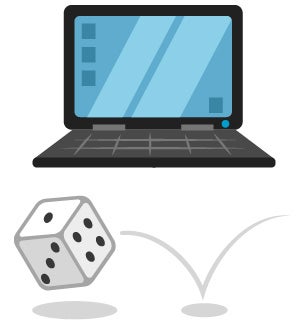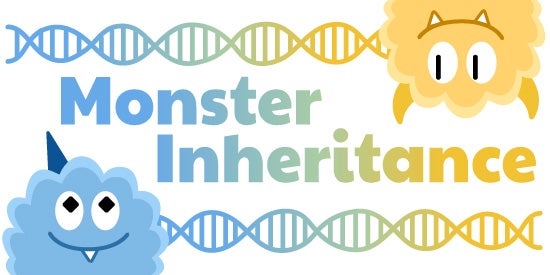DNA and Inheritance Activity - For Teachers
Teaching students about inheritance can be tricky, as it requires many examples, and many examples need to be simplified. In real life, inheritance is typically much more complicated than single genes influencing single traits. Our activity, Monster Inheritance, brings a simplified system to explain a simplified version of inheritance, designed for the age group.
For just a quick refresher on the basics of DNA, visit DNA ABCs.
This activity is designed for 5th grade and uses the 5E model.
It also meets some standards for 3rd grade. For use in 3rd grade, we suggest focusing mainly on the Engage, Explore sections, with a brief version of the Explain section.
Tips for Classroom Implementation
Time Required: This activity is designed to take about 90-120 minutes to complete, though it can be done in as little as about 75, if you are willing to shorten discussion time and eliminate optional slides.

Classroom set-up: Make sure you have the PowerPoint presentation. It is recommended you look through it and familiarize yourself with it - there is a slide in the presentation that is meant to be deleted! Notes for you are included in the speaker notes of the slides. There are also optional slides that you can feel free to use or skip as time and understanding dictate.
For day one, each pair of students will need a copy of the Monster Mixer Worksheet to work through. Students will also need some way of determining a 50/50 probability, such as a coin or a die (even/odd), it is ideal to pass that out with the worksheet. If you don’t have either method, students can get creative (e.g., an online coin flip tool) or just skip it altogether and pick one or the other.
Both a paper and digital version of the Monster Maker Elaborate activity are available. Follow the link and select “Worksheet Generator” to create paper copies. If students are completing the activity on paper, it is recommended to give students extra time and supplies like colored pencils to be able to draw their monsters. This isn’t required for the digital version, as the game creates the monster during game play.
Though there is no defined summative assessment for this activity, while partner or table groups are trying to define: “Trait”, “Inherited”, “Acquired,” “DNA,” and "Codon," it is recommended you check in on their progress. You can also have students write out their definitions on paper to collect it if you would prefer.
Tips: Make sure to review the PowerPoint and familiarize yourself with the key ideas before leading your class through the lesson.
You may also want to require each group to return their die/coin to you before they are allowed to leave class.
Objectives: After completing the lesson, students should be able to:
1. Explain that inheritance does not occur by blending traits but by inheritance of discrete traits from each parent.
2. Define traits, inherited and acquired, in relation to genetics.
3. Predict if traits are inherited or acquired.
4. Describe how DNA can pass genetic information from generation to generation.
Standards
Arizona Science Standards
Grade 5
5.L3U1.9: Obtain, evaluate, and communicate information about patterns between the offspring of plants and animals; construct an explanation of how genetic information is passed from one generation to the next.
- Many characteristics of organisms are inherited from their parents.
- Different organisms vary in how they look and function because they have different inherited information.
5.L3U1.10: Construct an explanation based on evidence that the changes in an environment can affect the development of traits in a population of organisms
- Other characteristics result from individuals’ interactions with the environment, which can range from diet to learning. Many characteristics involve both inheritance and environment.
- The environment also affects the traits that an organism develops. Differences in where they grow or in the food they consume may cause organisms that are related to end up looking or behaving differently.
Next Generation Science Standards
Grade 3
3-LS3-1.Analyze and interpret data to provide evidence that plants and animals have traits inherited from parents and that variation of these traits exists in a group of similar organisms.
3-LS3-2.Use evidence to support the explanation that traits can be influenced by the environment.
Read more about: Monster Inheritance
Bibliographic details:
- Article: Inheritance Activity - For Teachers
- Author(s): Dr. Biology
- Publisher: Arizona State University School of Life Sciences Ask A Biologist
- Site name: ASU - Ask A Biologist
- Date published: 25 Mar, 2025
- Date accessed:
- Link: https://askabiologist.asu.edu/experiments/teaching-inheritance
APA Style
Dr. Biology. (Tue, 03/25/2025 - 10:58). Inheritance Activity - For Teachers. ASU - Ask A Biologist. Retrieved from https://askabiologist.asu.edu/experiments/teaching-inheritance
Chicago Manual of Style
Dr. Biology. "Inheritance Activity - For Teachers". ASU - Ask A Biologist. 25 Mar 2025. https://askabiologist.asu.edu/experiments/teaching-inheritance
Dr. Biology. "Inheritance Activity - For Teachers". ASU - Ask A Biologist. 25 Mar 2025. ASU - Ask A Biologist, Web. https://askabiologist.asu.edu/experiments/teaching-inheritance
MLA 2017 Style
With a few exercises, our Monster Maker game, and a short presentation, your students will have a better understanding of DNA and inheritance.
Be Part of
Ask A Biologist
By volunteering, or simply sending us feedback on the site. Scientists, teachers, writers, illustrators, and translators are all important to the program. If you are interested in helping with the website we have a Volunteers page to get the process started.

